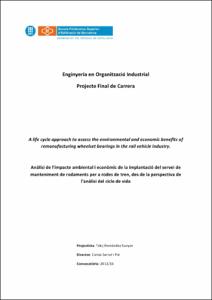Mostra el registre d'ítem simple
A life cycle approach to assess the environmental and economic benefits of remanufacturing wheelset bearings in the rail vehicle industry
| dc.contributor | Serrat Piè, Carles |
| dc.contributor.author | Fernández Sunyer, Tekij |
| dc.contributor.other | Universitat Politècnica de Catalunya. Departament de Matemàtica Aplicada I |
| dc.date.accessioned | 2013-06-07T10:09:19Z |
| dc.date.available | 2013-06-07T10:09:19Z |
| dc.date.issued | 2013-01 |
| dc.identifier.uri | http://hdl.handle.net/2099.1/18396 |
| dc.description.abstract | Rail vehicles’ wheelset bearings have to be replaced periodically as they reach the end of their operational life, so that the vehicles’ availability, reliability and safety can be maximised. There are two maintenance options available for decision makers: 1) scrap the used bearings and replace them with new ones, or 2) remanufacture the used bearings so that they can be restored and used again. Whilst both options are valid from a reliability point of view, the option to remanufacture the used bearings offers the possibility to reduce the amount of new components to be purchased, helping in turn to save energy and raw materials, as well as reduce waste and pollutants during the production process of the bearings. Furthermore, it may be desirable from an economic point of view, as it is generally much cheaper to purchase a remanufactured product rather than an entirely new one. The aim of this project is to analyse and compare the environmental and economic performance of the two maintenance options, providing relevant data that can help with the decision making. The methodology Life Cycle Assessment (LCA) analysis, ISO 14040, is applied to carry out the environmental analysis. Given the lack of a standardised methodology to perform the economic analysis, a Life Cycle Cost (LCC) model is developed and applied. In the environmental analysis, two main scenarios have been considered: 1) not using remanufactured bearings, and 2) using remanufactured bearings, throughout the vehicle’s life cycle. The results obtained show how, by using remanufactured bearings, an average of 60 % of materials and primary energy can be saved; a 62 % less of waste is generated; and, the emissions to air of harmful substances such as CO2, NOx or SO2 can be reduced about 65 %. Three different alternatives have been considered in the economic analysis. The first alternative considers the use of new manufactured bearings; the second considers the remanufacture of the bearings once; and the third alternative the remanufacturing of the bearings twice, thus reaching the limit of their operational life. The results obtained show that the maintenance costs of the wheelset bearings throughout the rail vehicle’s life cycle can be reduced by 23 % if the bearings are remanufactured once, and by 30 % if they are remanufactured twice, compared with using only new manufactured bearings. |
| dc.language.iso | eng |
| dc.publisher | Universitat Politècnica de Catalunya |
| dc.rights | Attribution-NonCommercial-NoDerivs 3.0 Spain |
| dc.rights.uri | http://creativecommons.org/licenses/by-nc-nd/3.0/es/ |
| dc.subject | Àrees temàtiques de la UPC::Edificació::Aspectes econòmics |
| dc.subject.lcsh | Product life cycle |
| dc.title | A life cycle approach to assess the environmental and economic benefits of remanufacturing wheelset bearings in the rail vehicle industry |
| dc.title.alternative | Anàlisi de l'impacte ambiental i econòmic de la implantació del servei de |
| dc.type | Master thesis (pre-Bologna period) |
| dc.subject.lemac | Cicle de vida del producte -- Avaluació |
| dc.rights.access | Open Access |
| dc.audience.educationlevel | Estudis de primer/segon cicle |
| dc.audience.mediator | Escola Politècnica Superior d'Edificació de Barcelona |
| dc.audience.degree | ENGINYERIA D'ORGANITZACIÓ INDUSTRIAL (Pla 2003) |


